If you haven’t heard of it, the La Jolla Concours d’Elegance in La Jolla, CA is a ‘Premiere (sic) automotive & lifestyle event’ that began 21 years ago. Its title incorporates two or possibly three languages and translates to ‘The Jewel Competition of Elegance’ if you translate it roughly from misspelled Spanish and French or ‘The Land Of Holes Competition of Elegance” Kumeyaay Native American language and French. Presumably, Land of Holes refers to the many sea caves dotting the coast in La Jolla, and not deep fried confectionery nor denigrating slurs about its residents. Despite being a Californian for roughly half of my life and being classified as a rabid car nerd, I had never been until this year.
[Ed Note: Carlos, who has written here before, is a designer who attended CCS in Detroit. He’s absolutely brilliant, and sees the world in ways I — an engineer — cannot imagine. So expect to see more of his design-stuff soon. For now, it’s a trip to a car show through his eyes. -DT].
![]()
My wife and I work at home, so our six-car-strong fleet doesn’t get a lot of use, tragically, especially since in Pasadena where we hang our many chic hats, everything is so conveniently nearby. Lola, my wife’s ’15 Fiat 500 Sport needed some exercise, so we used the La Jolla Concours as an excuse to give her a proper Italian tune-up. As the name name implies, the event is in La Jolla, a seaside San Diego neighborhood (pronounced “luh-hoyah” for the linguistically challenged). It’s held on a big patch of shabby lawn called Ellen Browning Scripps Park on a cliff that overlooks the North Pacific Ocean.
We set off the night before to avoid the usual clog of traffic around Camp Pendleton Marine Corps Base, and with the Aisin 6 speed auto in manual mode and of course, appropriately, ‘Sport’ mode engaged, I was able to unbridle all 101 feisty Italian cavallini, mustering every zestful gram of performance from the cheerful little Italian city car.
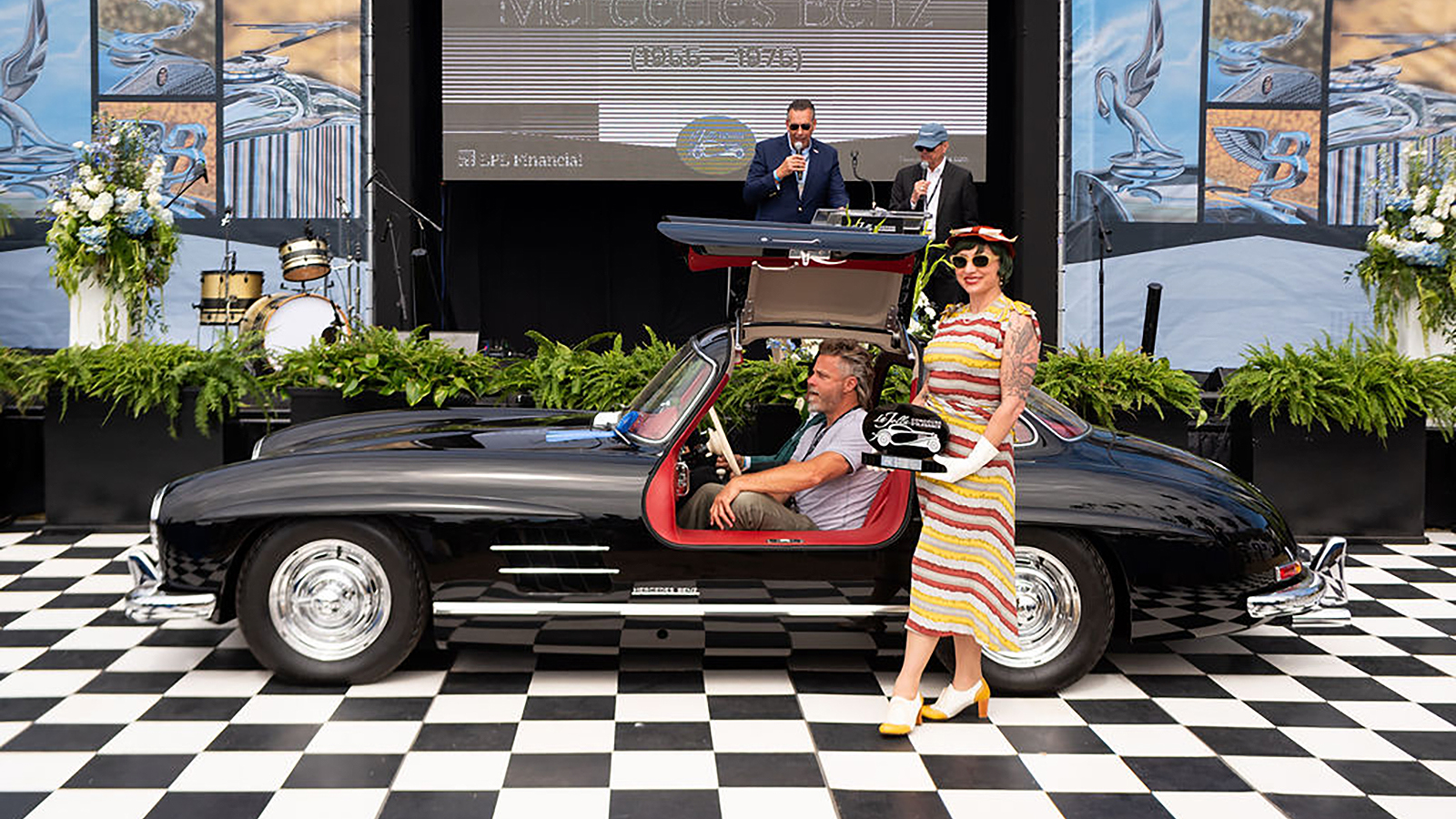
La Jolla itself is an extremely pretty place, both in aspects of its natural and human-made environments, and the frequently perfect weather only adds more sprinkles to the cake. Demographically, it’s older, very wealthy, and generally conservative in its automotive preferences, which means the classic car scene features many of the usual suspects, and this was reflected in the show entries, earning a mere cursory glance from me.
Regardless of their beauty, desirability and worth, there are many classics that fall into the ‘garden variety’ basket in my eyes. Yes, Porsche 356s, vintage 911s and Cobras are cool and all, but my eyes glaze at the sight of yet another example at a car show (E-types never fail to make me swoon, though). Somewhat predictably, The Best in Show award went to a perfectly restored black-on-red 300SL Gullwing with (gasp) fully chromed rims. It’s the blue chip equivalent of a yellow automatic Corvette with chrome wheels commonly burbling through the mean streets of Floridian retirement communities.
It’s not that that I didn’t enjoy the show, because I’m a car nut easily excited by anything automotive, but I left thinking it was just “nice.” When you’ve been mainlining car culture for as long as I have, I suppose it’s easy to get jaded, especially in the car-porn capital that is So-Cal. It must be said that in my day job, I am a partner in a firm that designs and produces various stuff, like branded events, furniture, and occasionally some architecture, so the E-Z Up 10 x 10 pop up tents, cardboard box trash cans, mismatched golf carts and haphazard event rental elements soured the caviar and champagne aspirations, making the $139 (cheapest) admission ticket a bit hard to swallow. It did not feel like premium experience, but again, I can be a snob sometimes when it comes to design.
But hey, onto the cars because this is The Autopian, not the Bitchy Designer Daily. For you dear readers, I seek to inform and expand consciousness with the outré, the unique and the unusual, so I focused my digital lenses on a few select conveyances. Also, please indulge my pretentious arty closeups of cool details.
The OSI-Ford 20 M TS is a elegantly understated coupé built from ’67 to ’68 by Officine Stampaggi Industriali, a small volume Italian coachworks, whose name translates to ‘Industrial Stamping Workshops,’ proving once again that anything sounds good in Italian, even when unimaginative (I’m looking at you, Maserati Four-Door). It was based on the very middle class and best selling Ford 20m TS Coupé, which was a popular equivalent to say, a Ford Falcon in Europe, and never sold on these shores.
This stunning ’67 example , which won the Mayor’s Award was powered by the venerable Ford Cologne 2.3 60º V6, seen on US shores in Ford Capris, Rangers, Bronco IIs, Scorpios, et al. In this iteration it put out 125 hp, which only had to move 2500 lbs, promising spirited performance for its time. Its design, penned by Sergio Sartorelli, also known for the scowl-aced VW Kharman-Ghia Type 34 looks like something an Italian James Bond could drive (Giacomo Legame?). Jason Torchinsky would immediately recognize its ubiquitous tail lamps from a humble lat 60’s Fiat 850 sedan and seen on everything from the Lancia Stratos, to the Bizarrini Strada and the Alfa Romeo TZ2, all of which were present at the show.
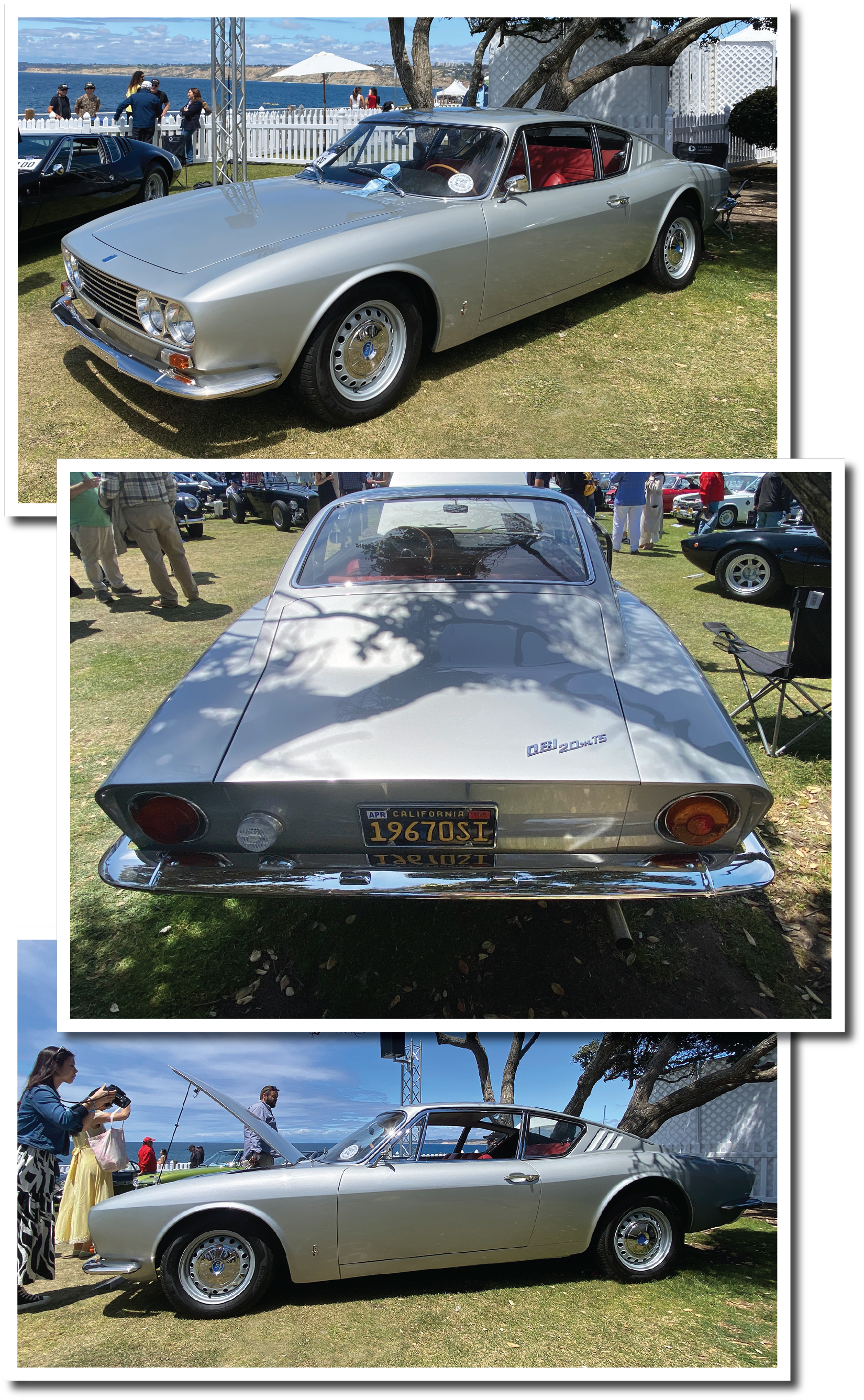 I pride myself in possessing a considerable mental database of obscure cars and other useless trivia, but this petite BMW 1600 GT surprised me. It’s because it’s not really a BMW but a rebadged GT coupe from Glas, a German carmaker BMW bought in ’66 for its patents, most notably the first production belt-driven OHC engine.
I pride myself in possessing a considerable mental database of obscure cars and other useless trivia, but this petite BMW 1600 GT surprised me. It’s because it’s not really a BMW but a rebadged GT coupe from Glas, a German carmaker BMW bought in ’66 for its patents, most notably the first production belt-driven OHC engine.
They ditched Glas’ 1.3 and added the BMW’s 1.6 from the 1602 along with its distinctive taillights and called it a day, offering it for a mere two years. If it looks Italianate it’s because it was designed Pietro Frua who also designed the OG Quattroporte in ’63, as well as other Maseratis and Glases. I find it charming and characterful, but its face reminds me a a bit of Sid, the sloth from the Disney’s Ice Age.
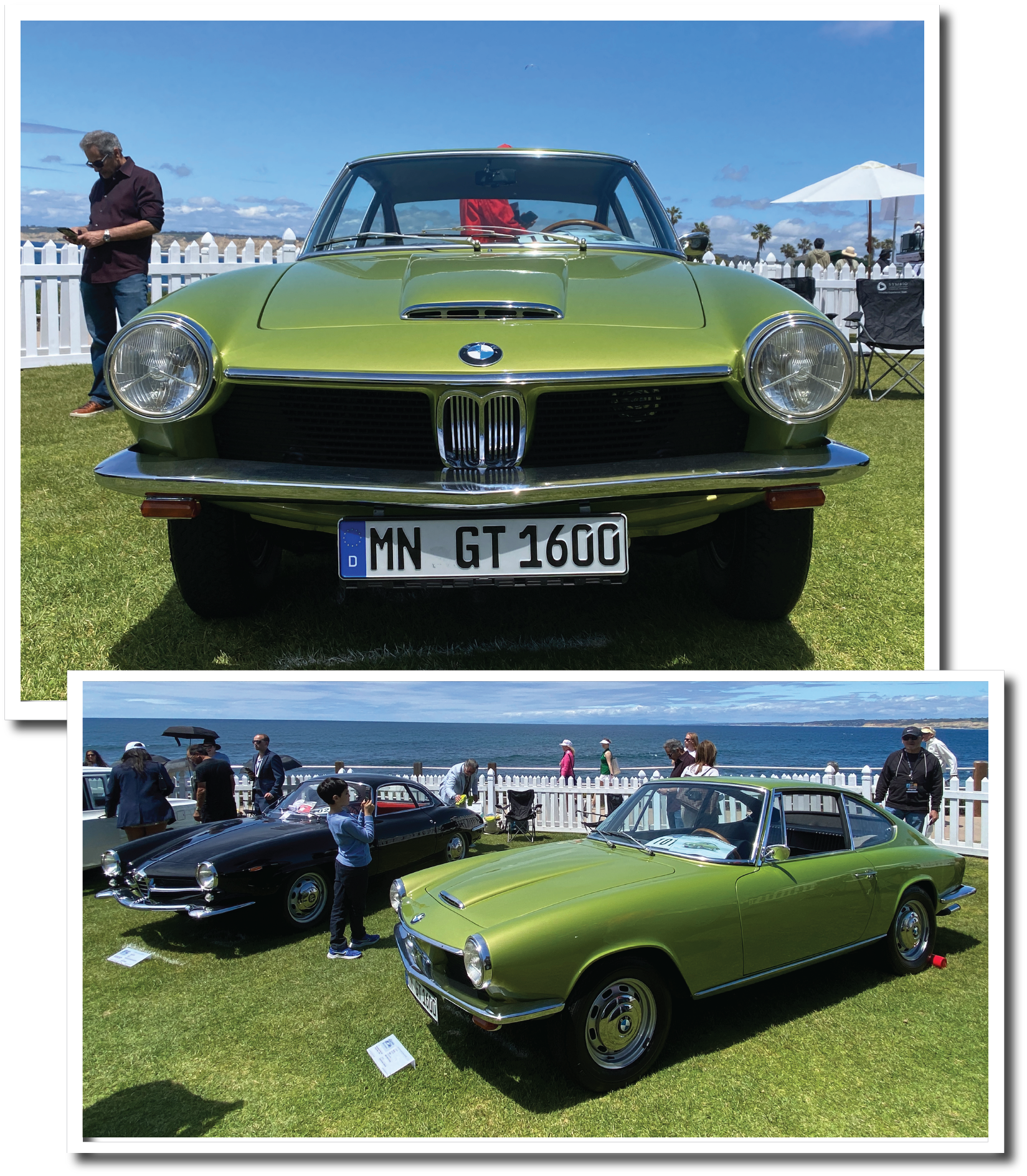
I love me some coupé utility trucklets and this funktastic El Catalina prototype delivered with its far out jet age styling and red cargo bed. It was a hand built one-off built by GM using Catalina and El Camino parts, that didn’t enter production after GM decided the small market niche was sufficiently populated by the Ford Ranchero and Chevrolet El Camino. Its dramatically sculpted hoof concealed a two-barrel, 280-horsepower version of the Catalina’s 389-cubic-inch V-8 engine connected to a four-speed Hydra-Matic automatic transmission.
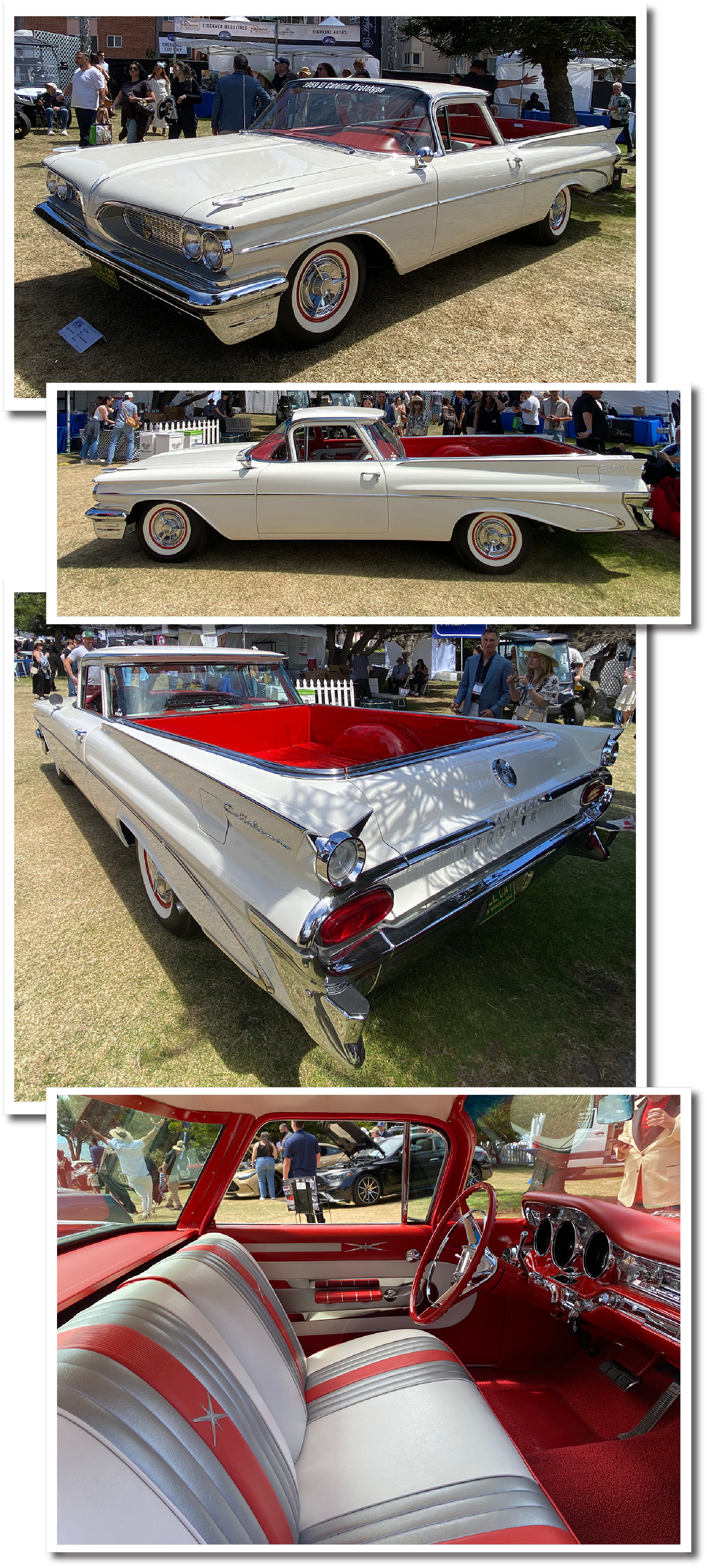
This sexy AF ’65 Alfa Romeo Giulia TZ2 in Competition FIA GT Berlinetta guise deservedly won best of class in the Historic Race Cars category, and I was fortunate to enjoy seeing and hearing it start up, run and rev on the way to the podium. It manages at once to be elegant, aggressive and friendly like it wants to be your friend and help you win races while also making you look impossibly cool and stylish.
As many of you know, TZ stands for Tubulare Zagato, referring to its tubular spaceframe and Zagato coachwork. Its many scoops, vents, bumps and straps somehow work together to deliver a purposeful aesthetic that reminds me of WWII fighter planes. Keep your M cars and AMGs; I would like a road version of this please.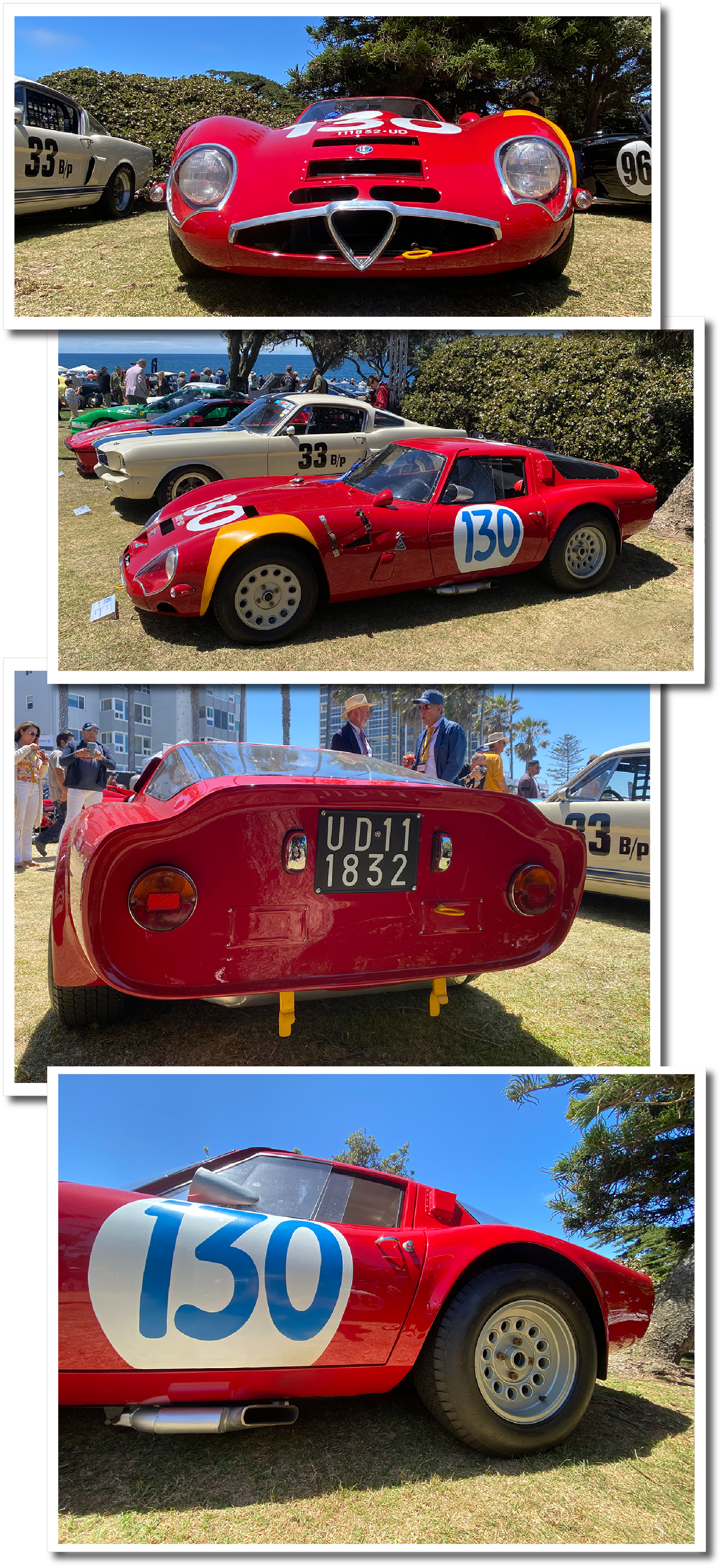
Its famed all aluminum DOHC twin plug, (1.6 L; 95.8 cu in) with dry sump lubrication produced 170 bhp (127 kW) at 7000 rpm. With its Kamm tail aerodynamic and only 1,370 lbs to move it pushed this sexy beast to a top speed of 152 mph. During its three years of production, TZ2s took class wins in the 1000 km of Monza 12 Hours of Sebring, the Targa Florio, 1000 km of Nürburgring,6 Hours of Melbourne, the Giro d’Italia and the Criterium des Cevennes. Proper!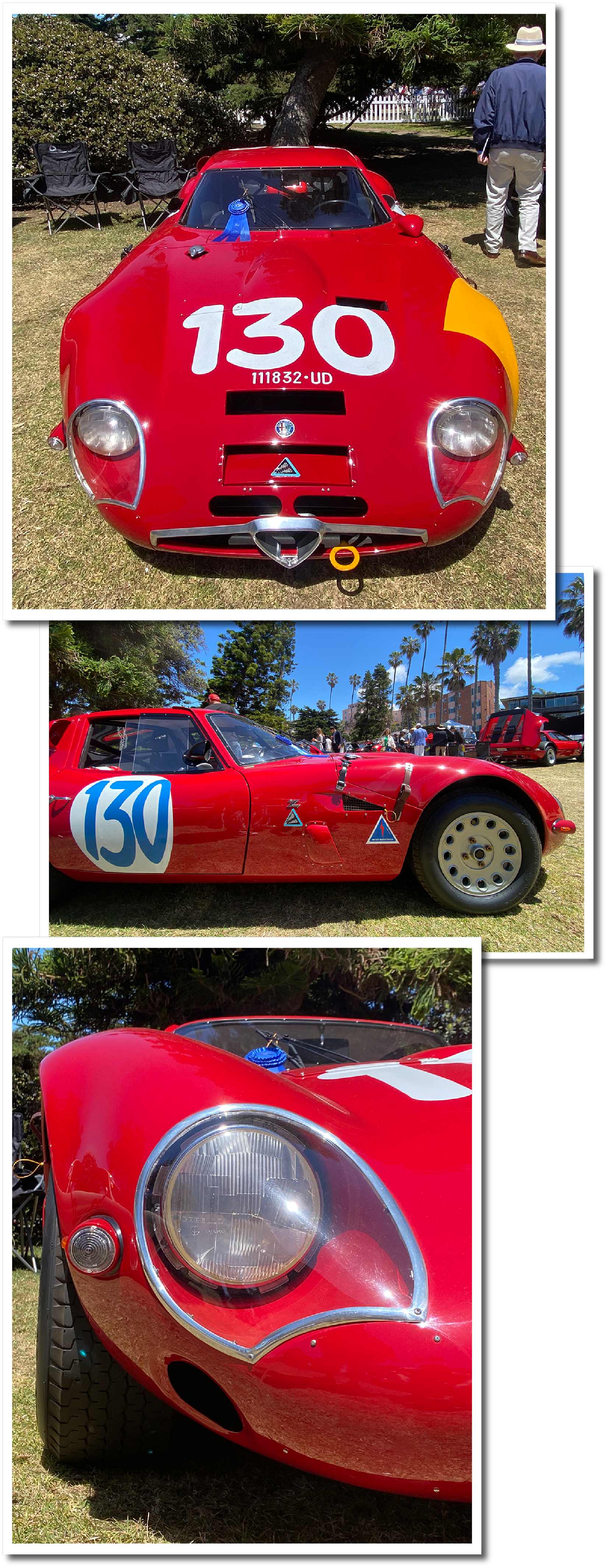
My hunger for automotive kink was satisfied by my personal highlight of the show, the ‘Spirit of San Diego’ a Citroen 2CV Flying Car, from the San Diego Air & Space Museum’s collection. It was commissioned in the late 90’s by Forged Metals Inc as a promotional vehicle, and subsequently shown at the Paris Air Shows of ’99. ’01 and ’03. Although it looks convincing down to its yoke controls and its rear mounted air cooled flat 2 visible through cowl vent, it’s not air worthy, sadly, most obviously because the propeller seems to be mounted backwards. Add this to my list of things I would buy if I were an eccentric multimillionaire. In the meant time, my search for a scale model of it has begun.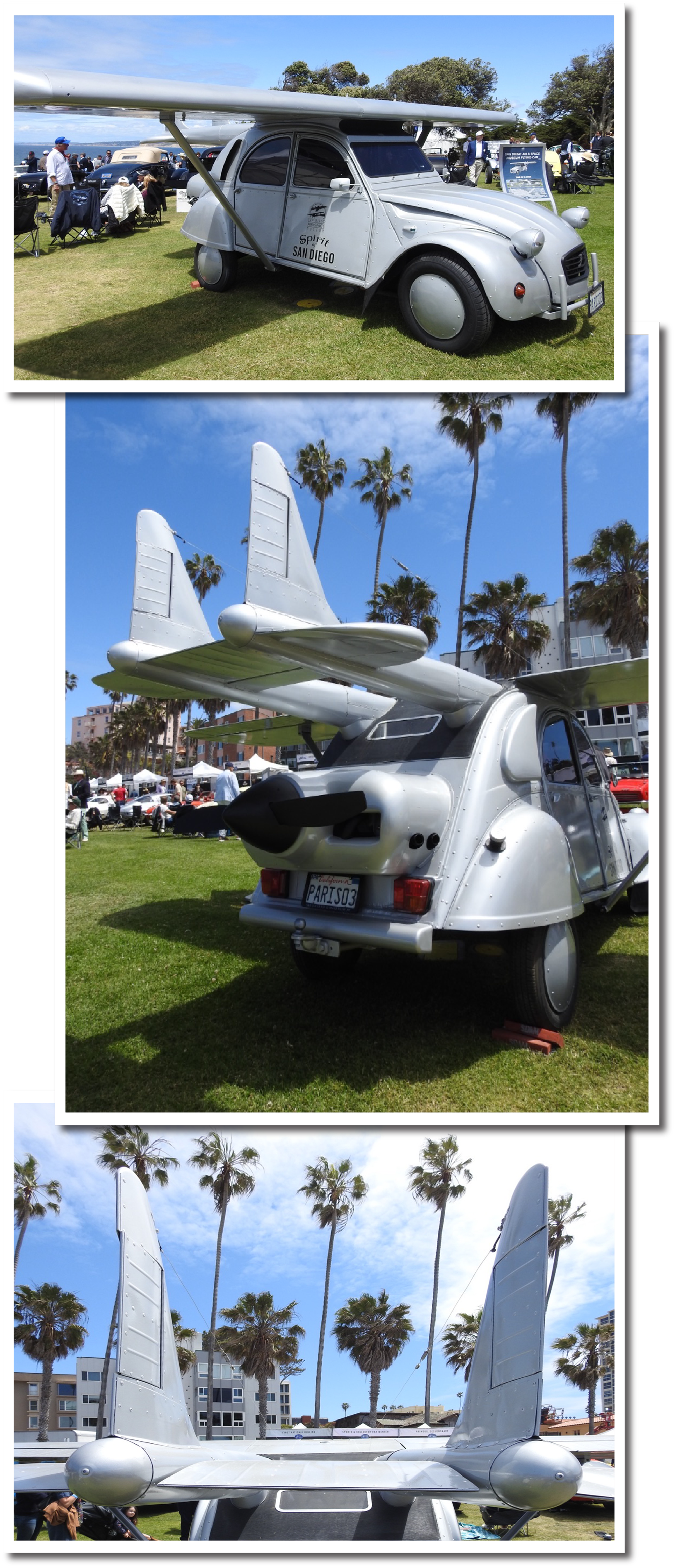 Despite my misgivings about the event presentation quality, I will acknowledge the diversity of content as the hot-rod contingent showed: plenty of restrained customs with tasteful and unique details. The silhouettes of hot rods don’t vary much, so I focused on the delicious and inventive details that really give them their individuality.
Despite my misgivings about the event presentation quality, I will acknowledge the diversity of content as the hot-rod contingent showed: plenty of restrained customs with tasteful and unique details. The silhouettes of hot rods don’t vary much, so I focused on the delicious and inventive details that really give them their individuality.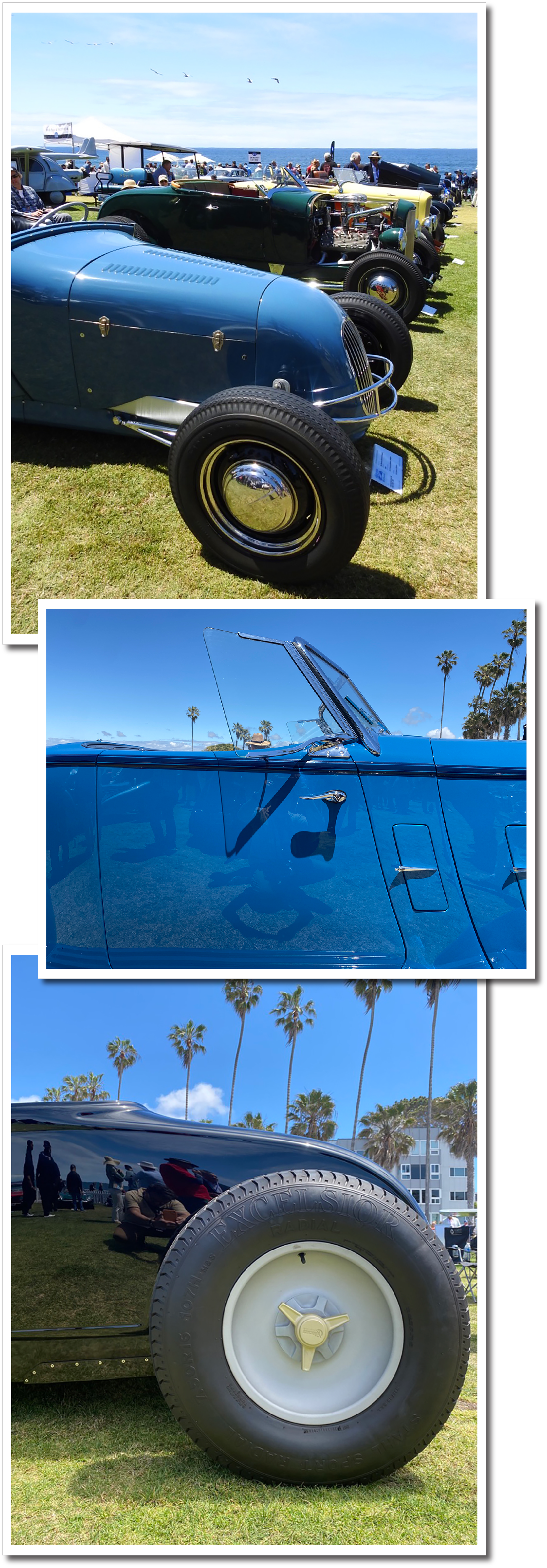
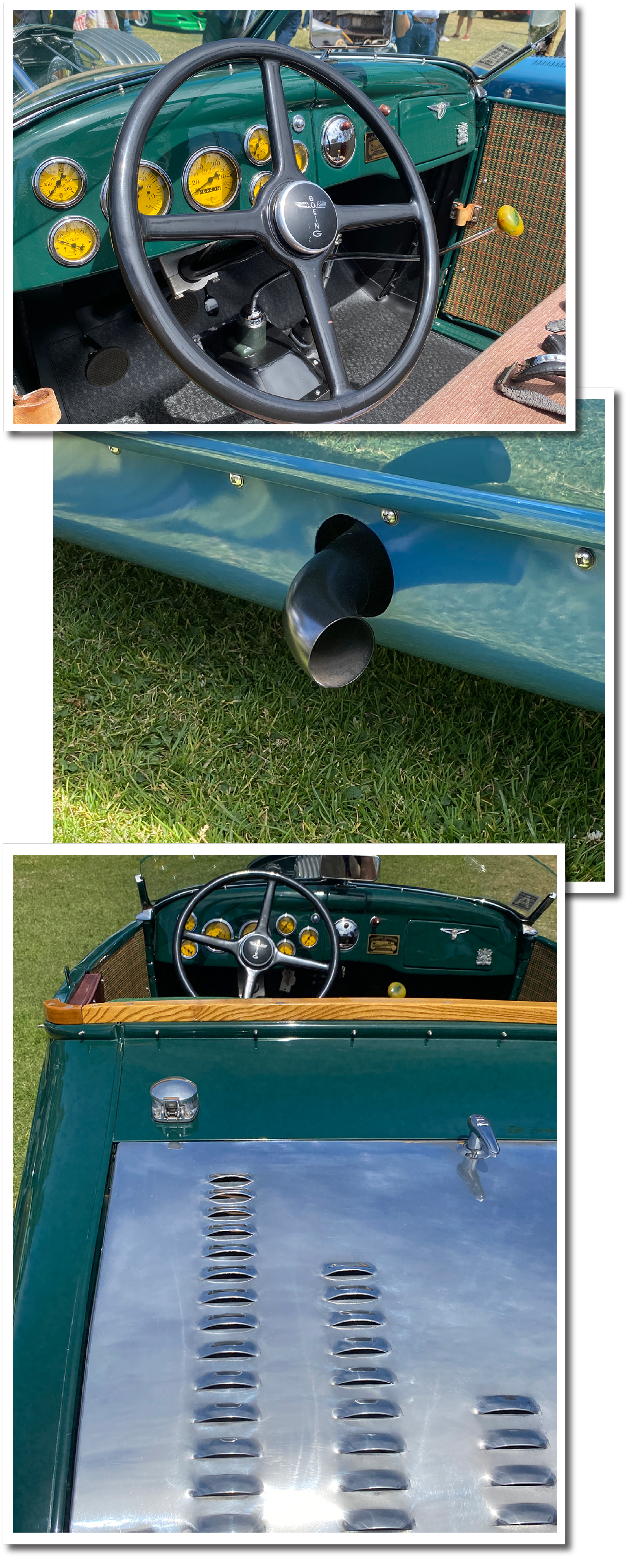
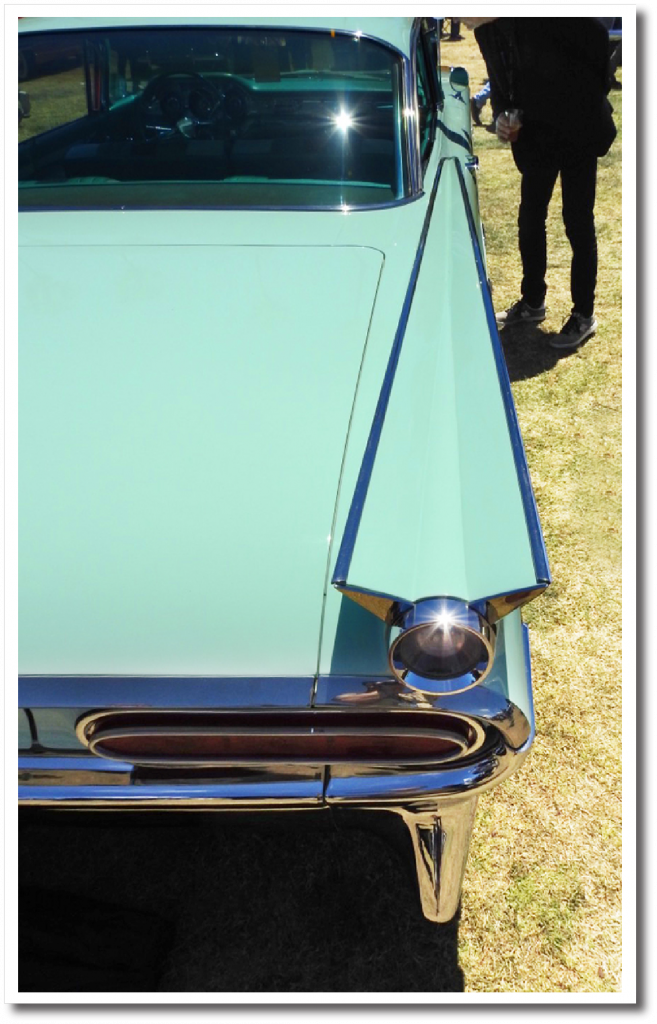
The Fabulous Fifties were well represented in glorious paint shades as well. Again, some standard classics of the era cast large shadows on the green, so got I close up and personal with the less common models. Their glorious sculpted extravagance never ceases to amuse, and the quality of the cars on display was superb.
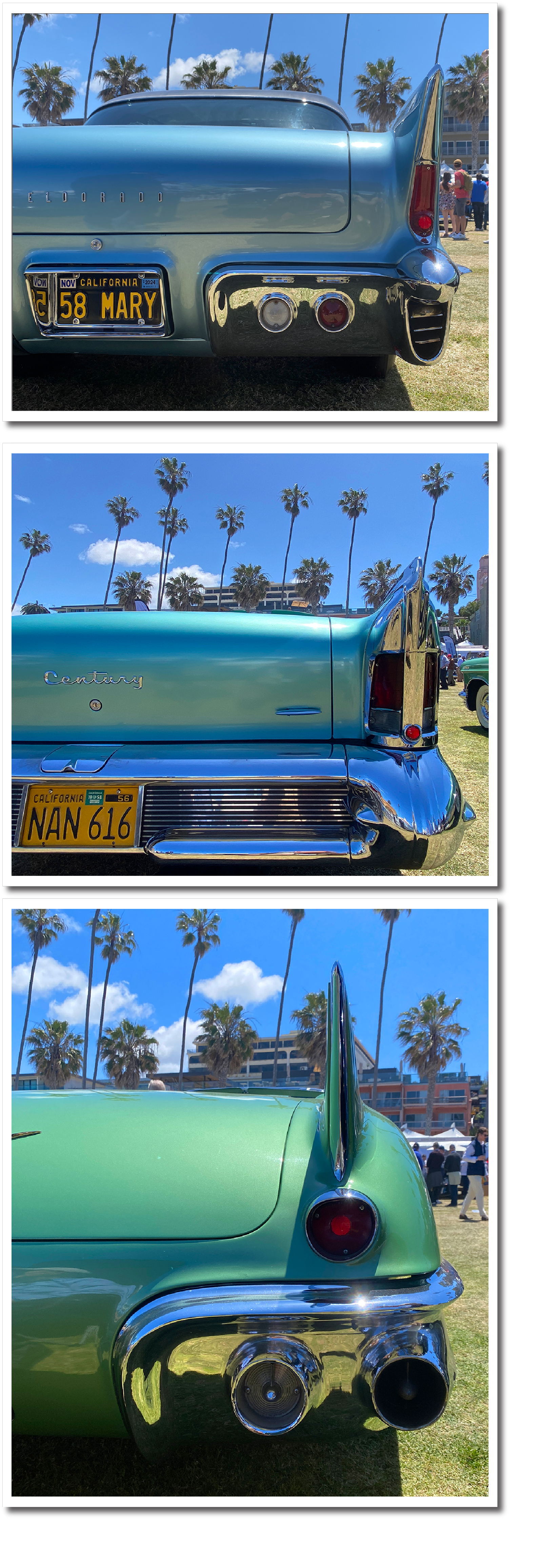
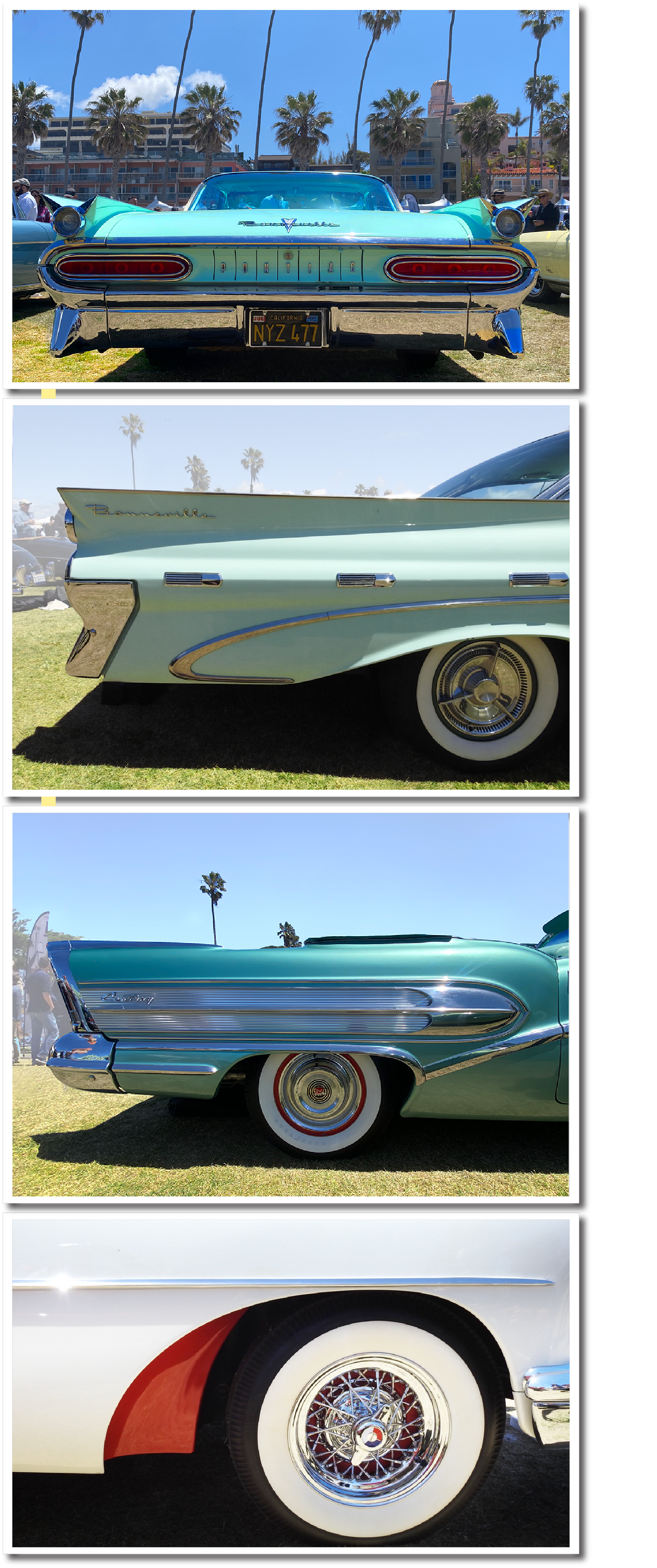
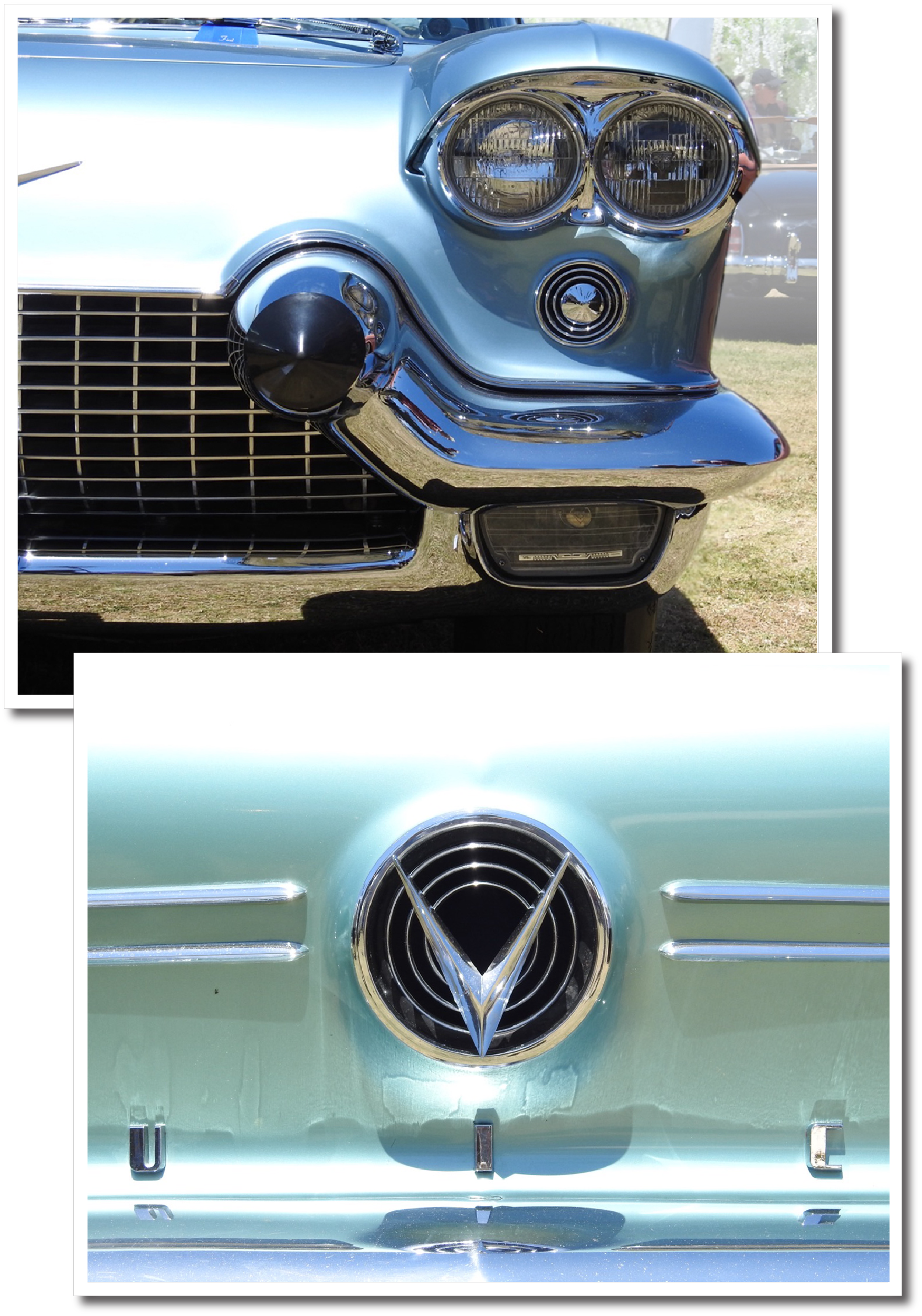 Very few pre-war era cars resonate with me, as I don’t find them very distinctive, but their section did boast some flamboyant icons that were true works of automotive art, if you will excuse the well-worn cliché. I had met them several times before at other events, and I’m guessing most of you have also seen them so, I present them with some artistic framing and closeups. Also, I had difficulty in getting human-free shots because I was too lazy to get up early enough for the pre-event media hour. I’m simply not a morning person.
Very few pre-war era cars resonate with me, as I don’t find them very distinctive, but their section did boast some flamboyant icons that were true works of automotive art, if you will excuse the well-worn cliché. I had met them several times before at other events, and I’m guessing most of you have also seen them so, I present them with some artistic framing and closeups. Also, I had difficulty in getting human-free shots because I was too lazy to get up early enough for the pre-event media hour. I’m simply not a morning person.
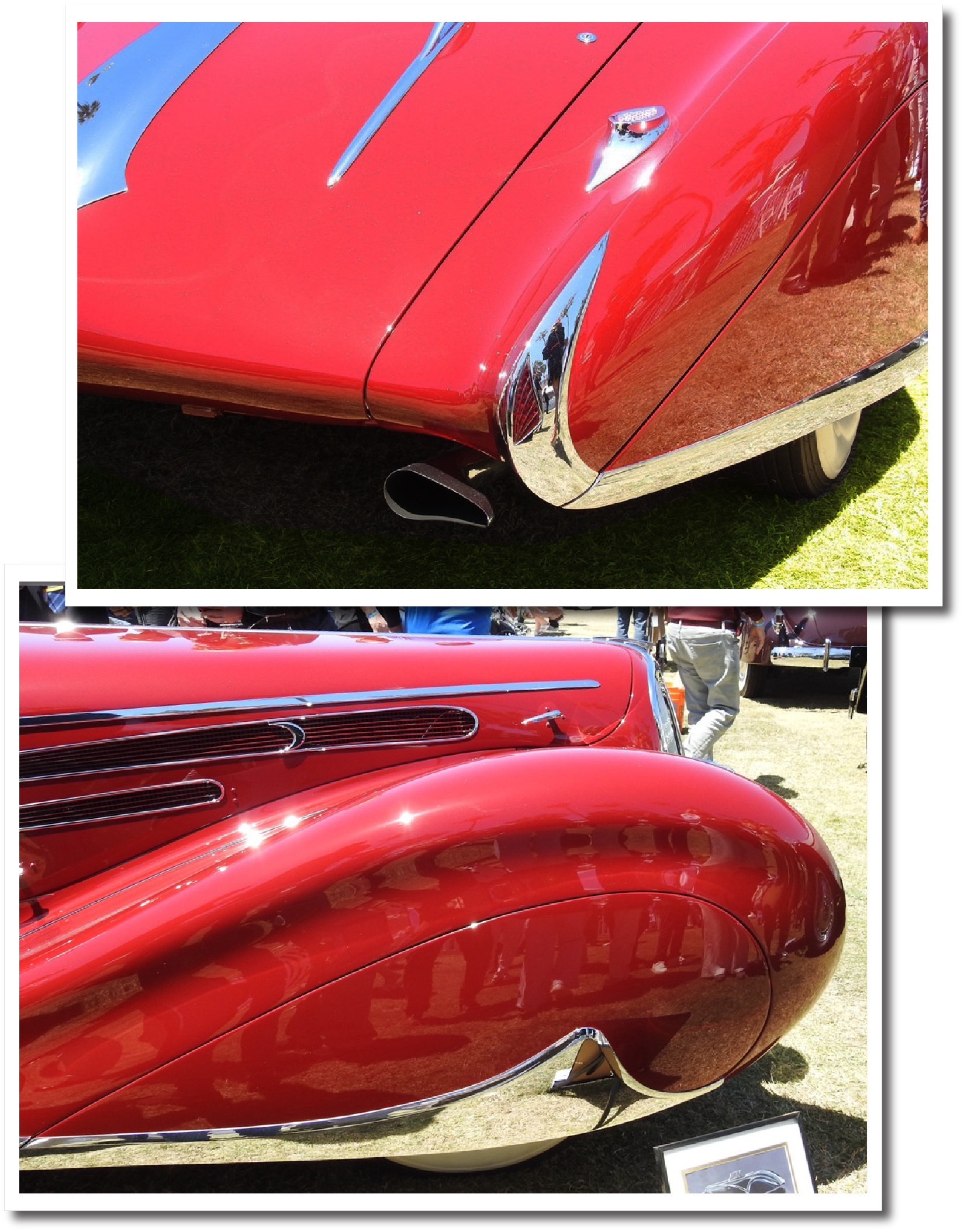
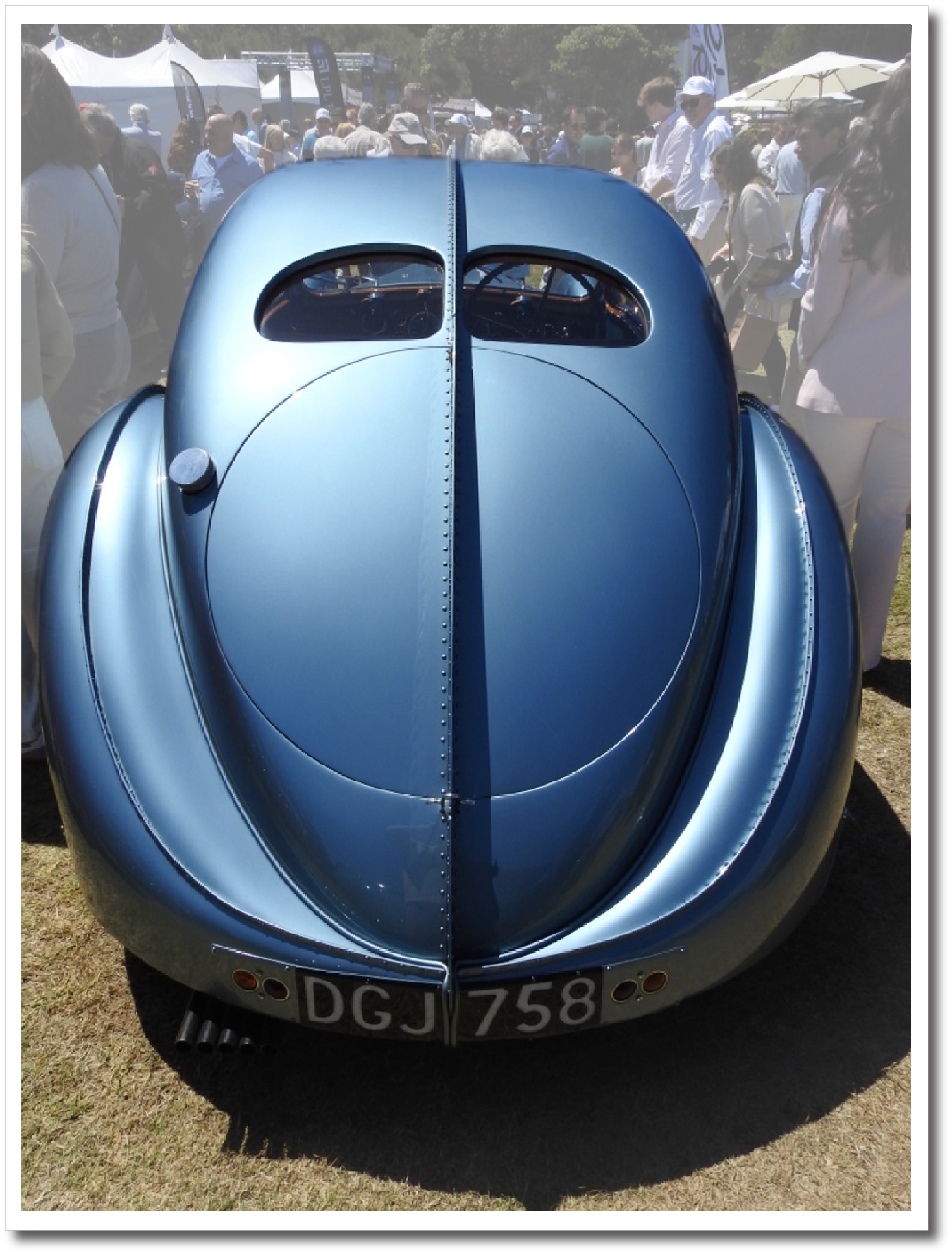
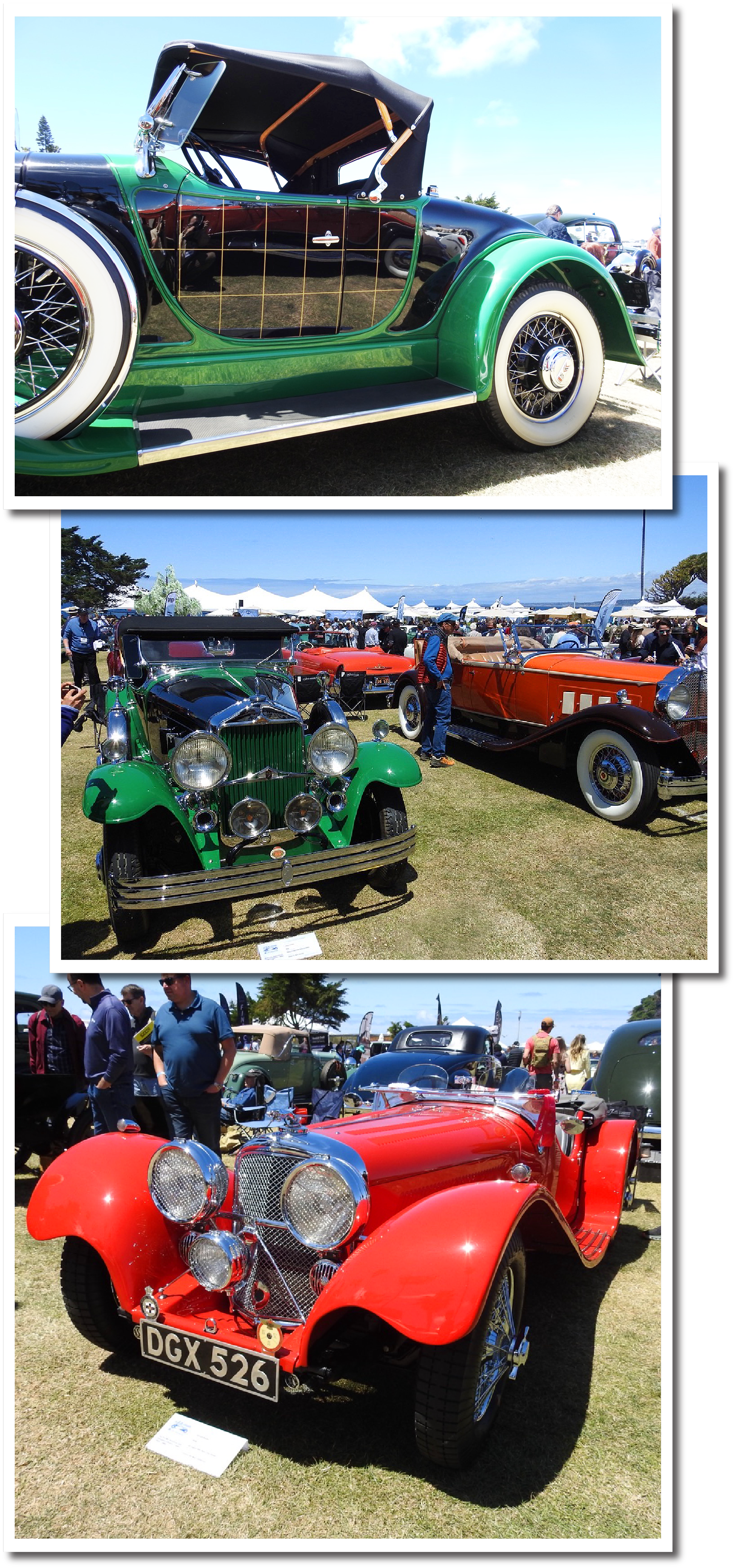
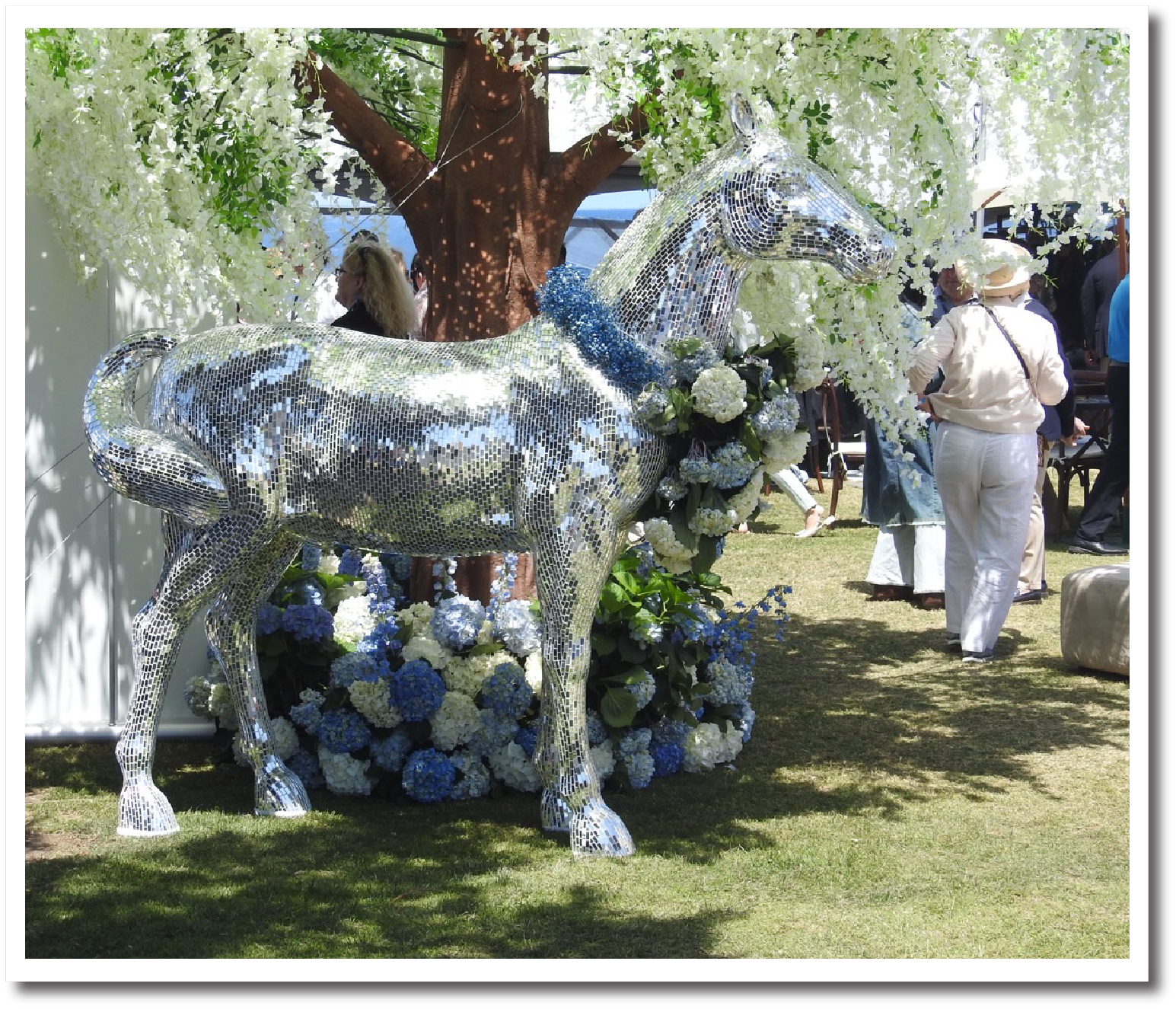
It might surprise you to learn that racing cars are hit or miss in capturing my interest, especially as sponsorship as we know it today gradually engulfed the cars in haphazard jarring collages of brands and slogans. I also tend to gravitate towards production-based cars as find them more relatable, but there was a golden era in the 60’s and early 70s that struck a near perfect balance of function-driven purposeful form.
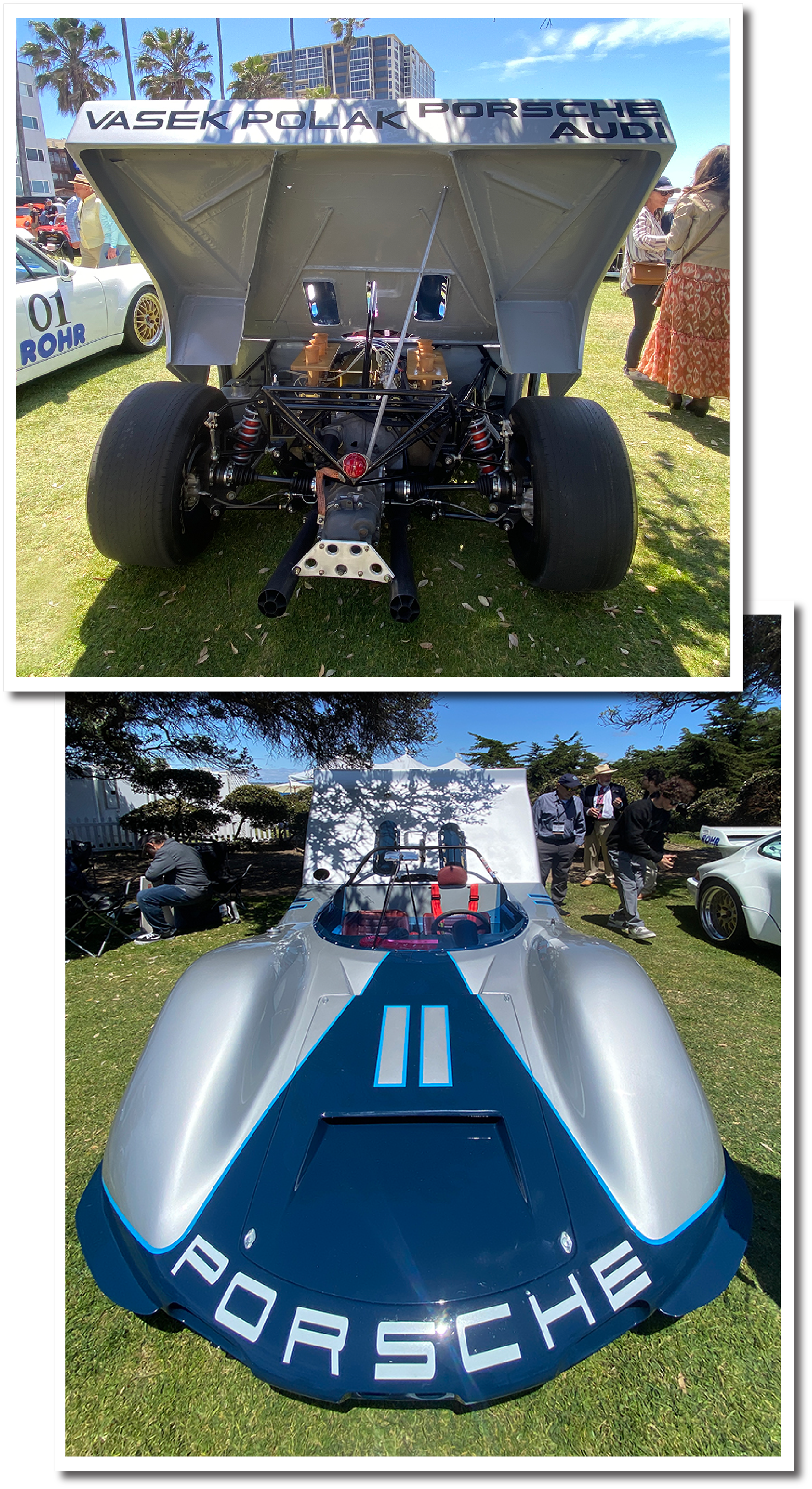
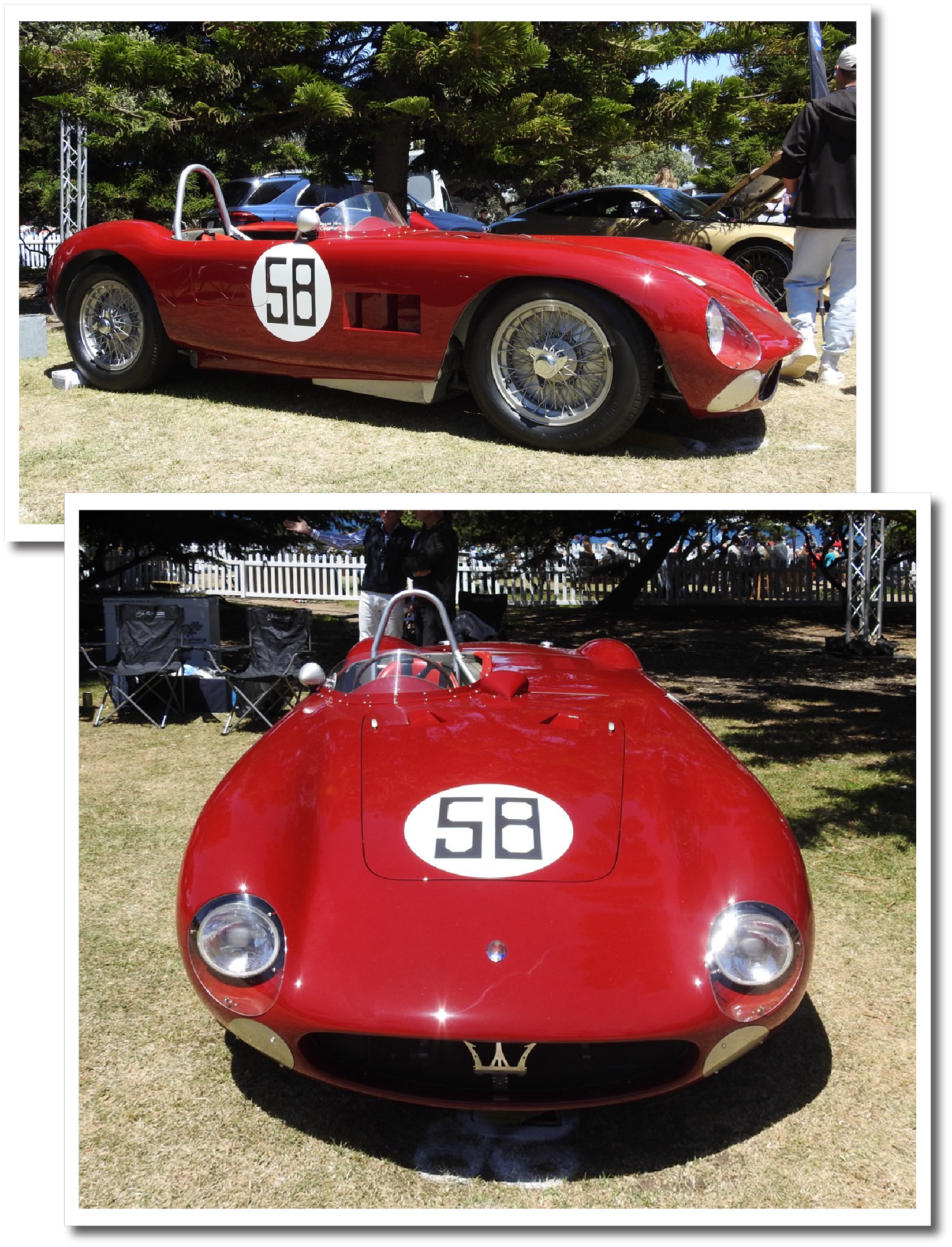
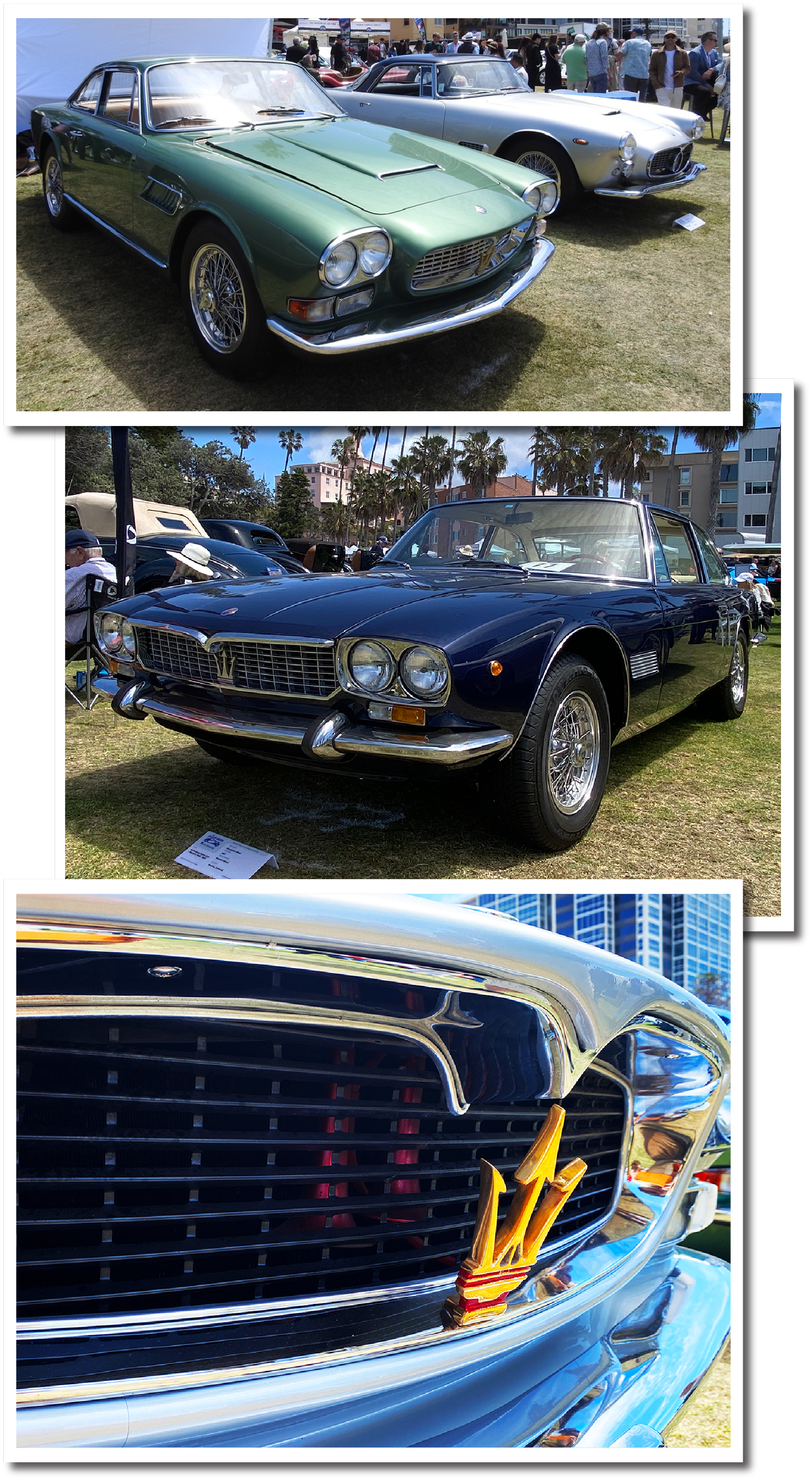
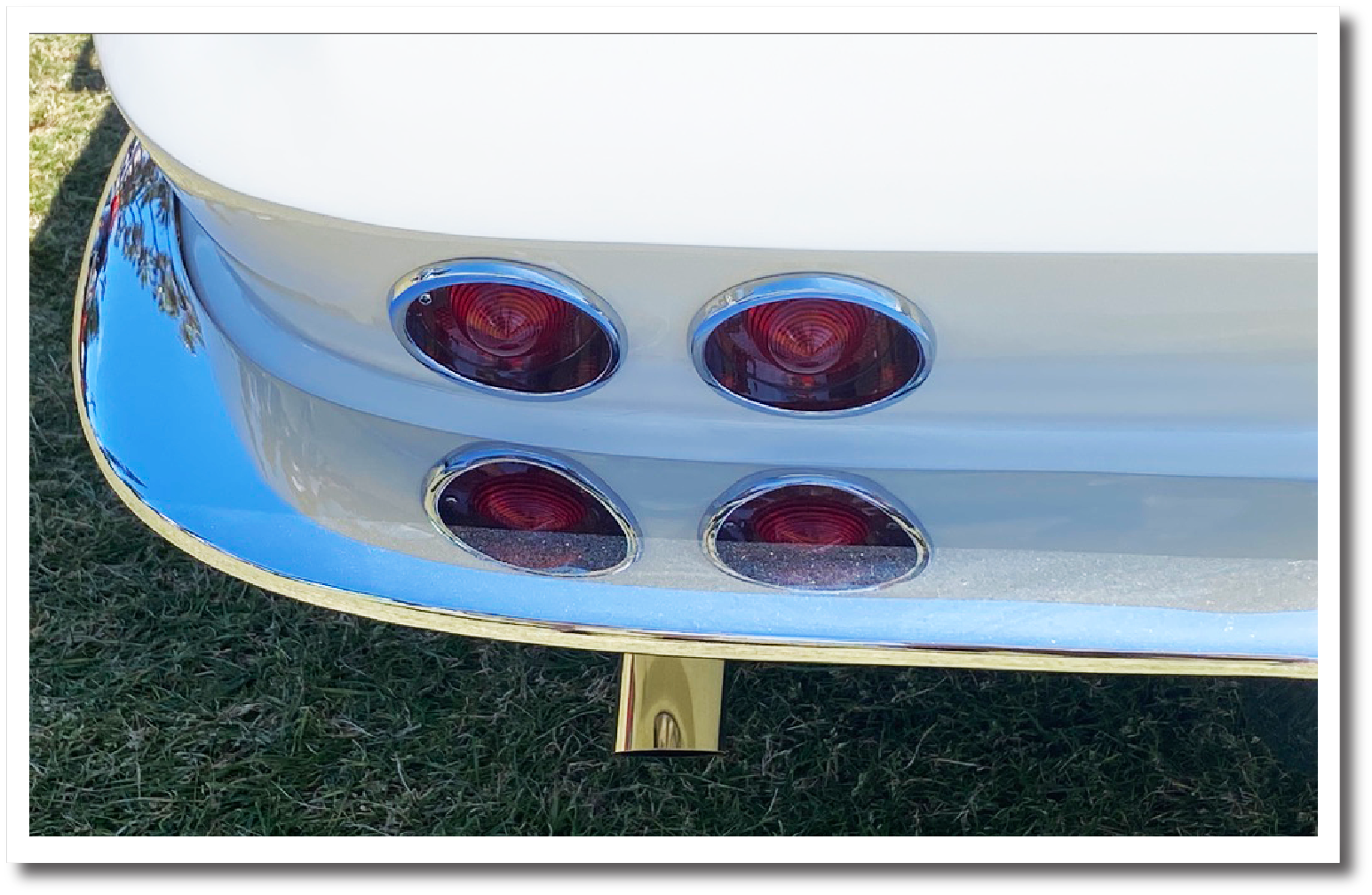
Outside the show there was a smattering of late model exotics with cheesy event graphics, which I mostly ignored (sorry; like I said I’m snobby about this due to my work), proceeding instead to the sharply inclined street that leads to event entrance. There I found Rezvani, a low volume manufacturer of specialty vehicles based in So Cal, halfheartedly displaying three of their offerings.
I applaud the efforts and their vehicles are interesting but the model mix is all over the place which makes it harder to take them seriously. The Beast, as far as I can tell is a C8 Corvette with a rather attractive bespoke body evoking British exotics, available in 750hp or 1000hp versions but its eye watering starting price of $585k seems hugely ambitious considering a ZR-1 goes for $221k and is backed by one planet’s largest manufacturers.
Its SUVs, based on Escalades and Gladiators, look cool, but only in the context of a post apocalyptic Sci Fi movie or a Halo video game installment. I can’t imagine wanting to ever meet anyone that owns one. Then there’s the Retro, which wasn’t at the event and is a current model Porsche 911 with a modern Le Mans body. It looks fantastic, but crikey, just pick a lane!

This Maserati Shamal is one of 369 produced between 1990 and 1996, and much more than an updated BiTurbo with m0re power. It’s p0wered by a DOHC Twin Turbo 3.2 V8 producing 322 hp, which is not heavily burdened by its 3,100 lb weight.
Its contrasting B-Pillar, which wraps into the roof, is actually an integrated roll bar. The spoiler at the base of the windshield is another unique design element, also seen on the last version of the DeTomaso Pantera, which, like the Shamal was redesigned by the great Marcello Ghandini, known for penning the original Lamborghini Countach and Lancia Stratos.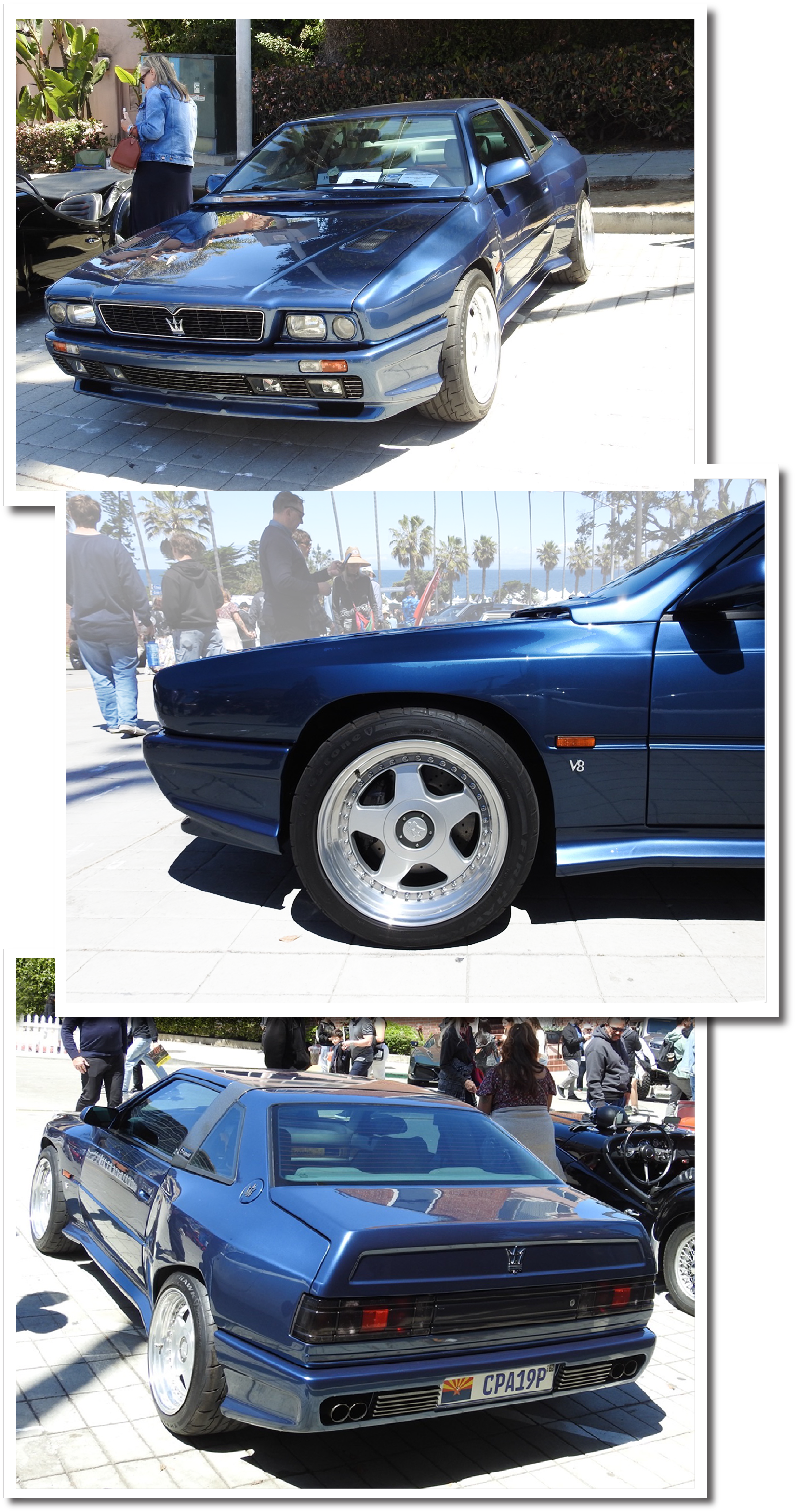
The Cobra is one of those ‘cool’ cars that don’t do much for me anymore because of the millions I’ve seen, the vast majority replicas with wavy fiberglass bodies in tacky color combos barely covering oversized extreme deep-dish modern chrome wheels. I can’t guarantee that this one is genuine, although it looks very authentic, but damn it looks good, period correct and tasteful.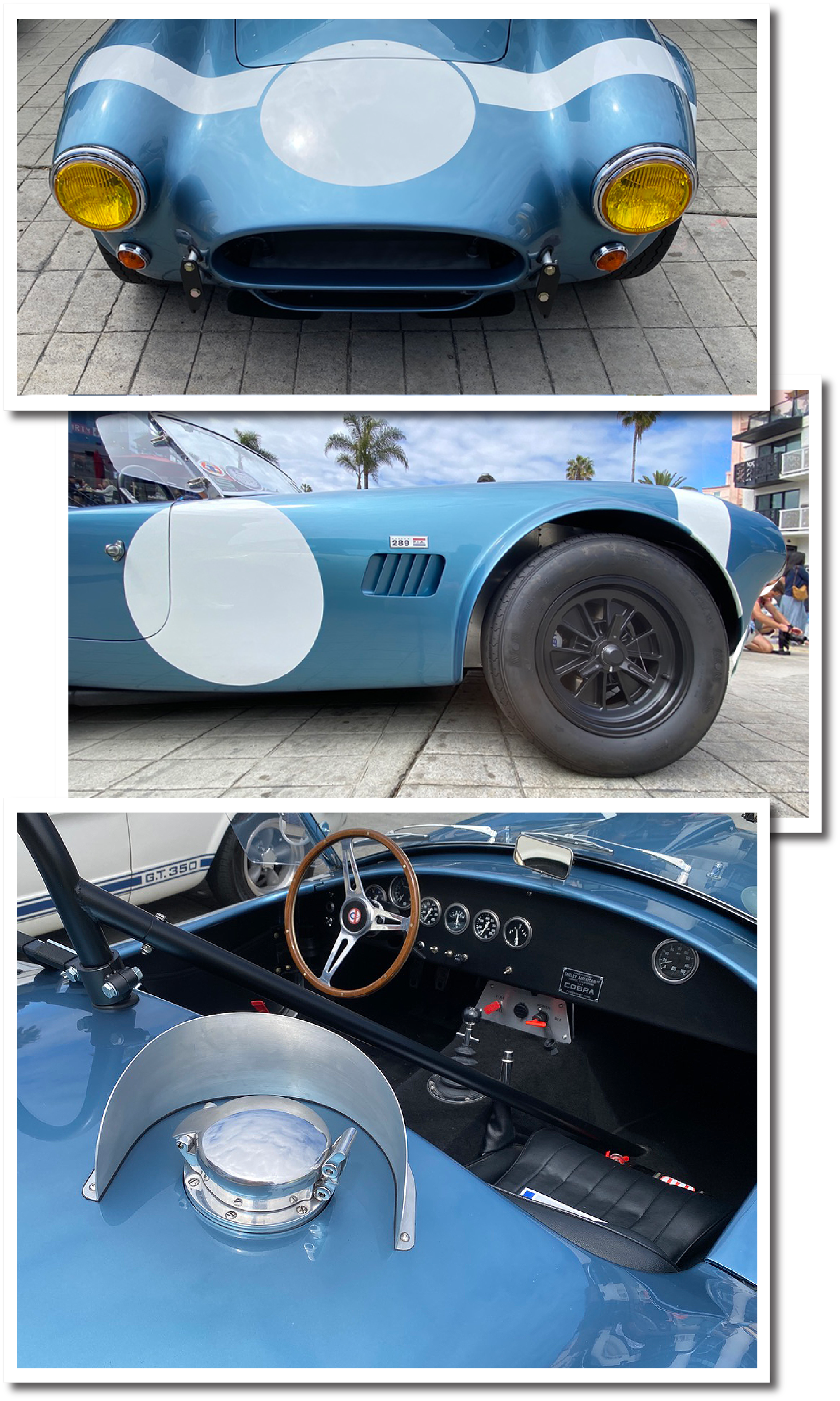
The chrome wheels and racing stripes check many Corvette cliché boxes, but the gull wing conversion seemed to be very well done! The slightly concerned looking petite silver coupe at the bottom is a ’64 Ghia 1500 GT, based on a shortened Fiat 1500 Saloon chassis and mechanicals.
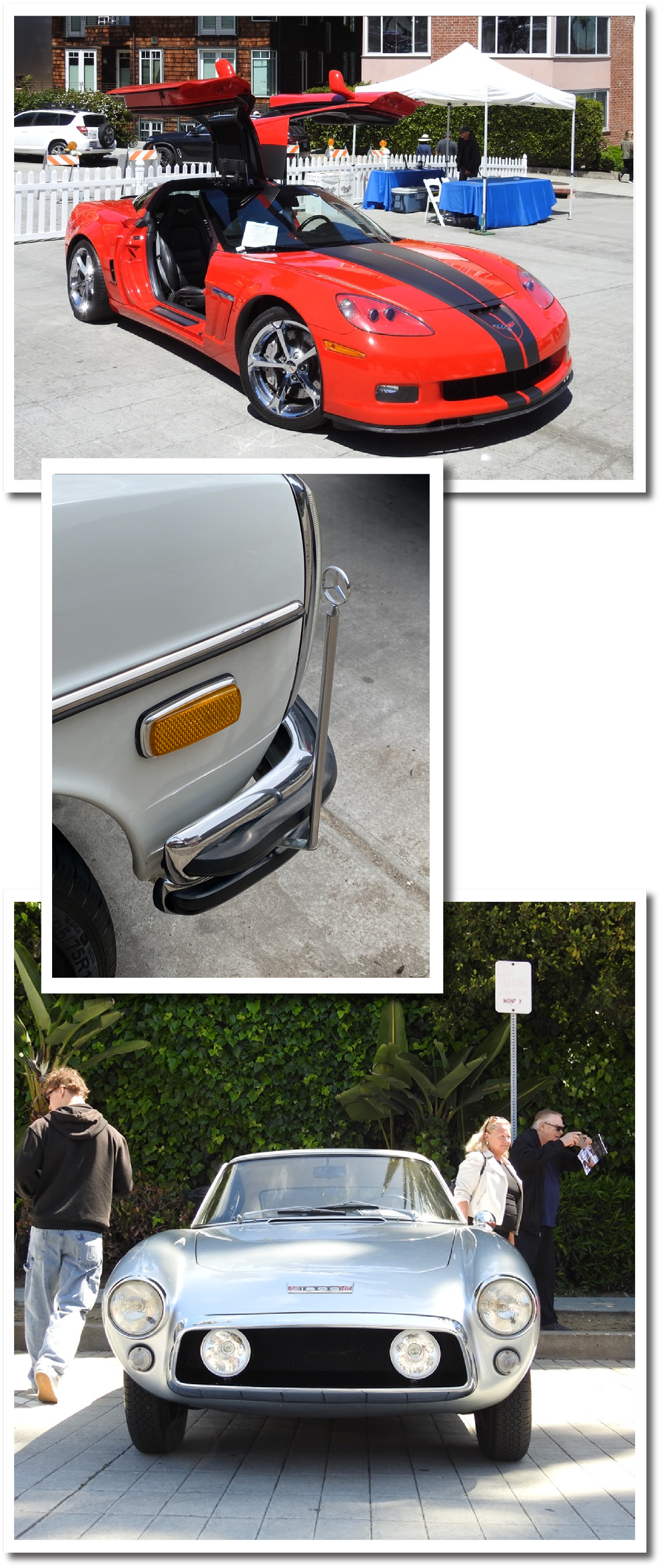
The interesting stuff wasn’t just in the show. On the night before the event, while searching for some grub, I spotted this Cobrari and approached it with a hearty scoff in the chamber, ready to lay snide critique, but upon closer introspection found that it looked quite good, was well finished and detailed, and sported a V12 poking through the hood, complete with velocity stacks. Damn. After some quick smartphone research I learned that this Anglo-Italian-American mash-up is made by Taormina Motorsports in Redwood City, CA and uses a genuine 6.0 Ferrari mill from a 599. Okay, okay….
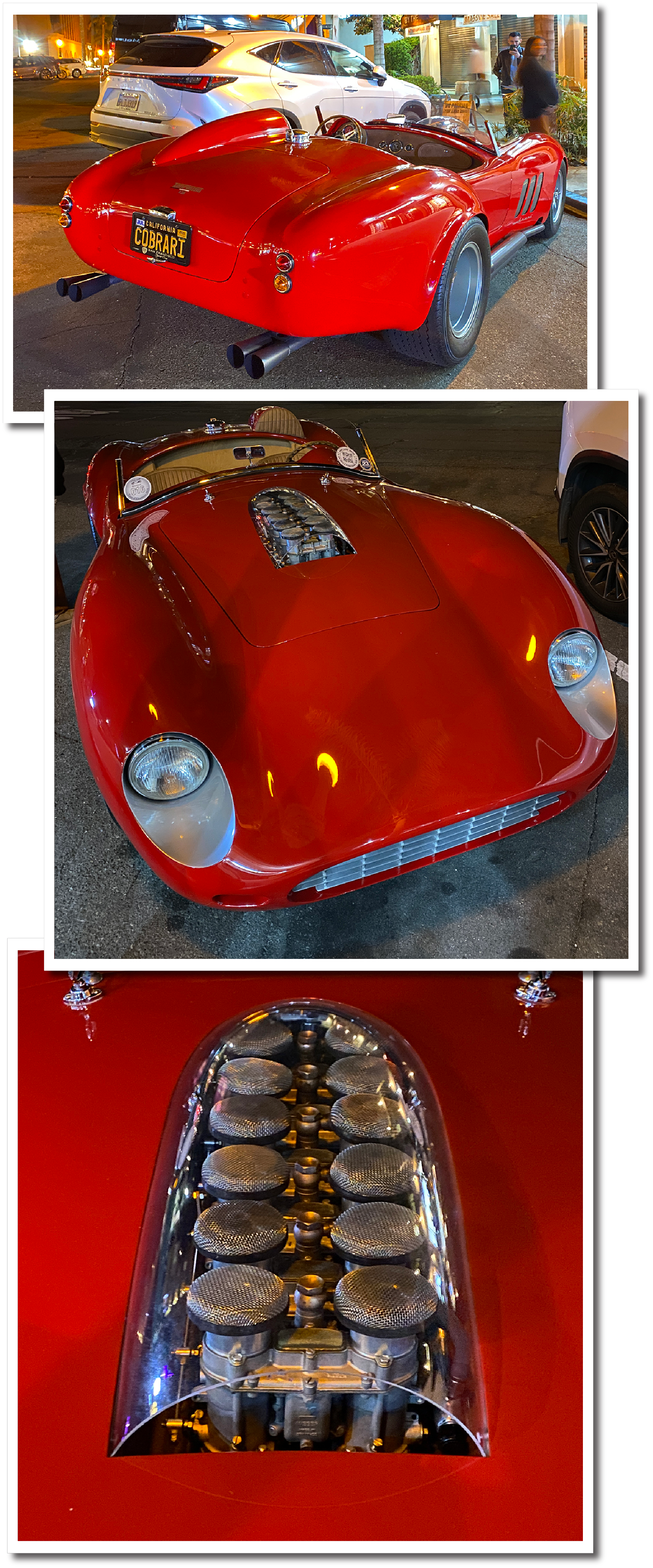
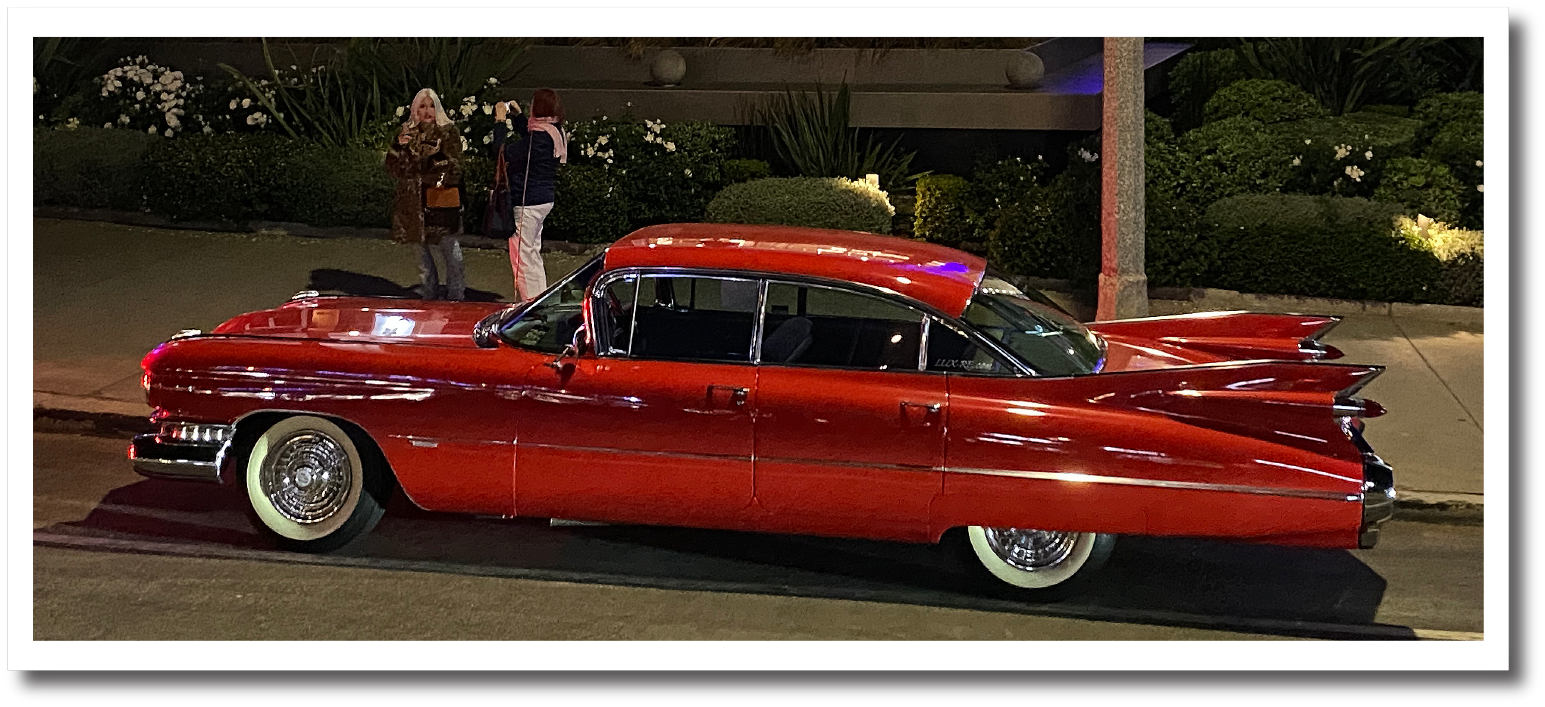
I left feeling like the La Jolla Concours was a nice way to spend the better part of a Sunday, but to this calloused enthusiast it was juts OK as an automotive experience, and the “true” gear head vibe was mild. In contrast, last year’s Macchinissima was superbly curated and presented, thanks in part to the wise selection of the Los Angeles River Center and Gardens as the venue. It was also a veritable bargain at 50 bucks for entry rights. However, if you live near San Diego and like to make it rain, I wouldn’t recommend against the La Jolla Concours. I did manage to pluck quite a few gems among the standard bearers after all. Perhaps next year I’ll exercise another car from my fleet, but LJCE, you can do better.
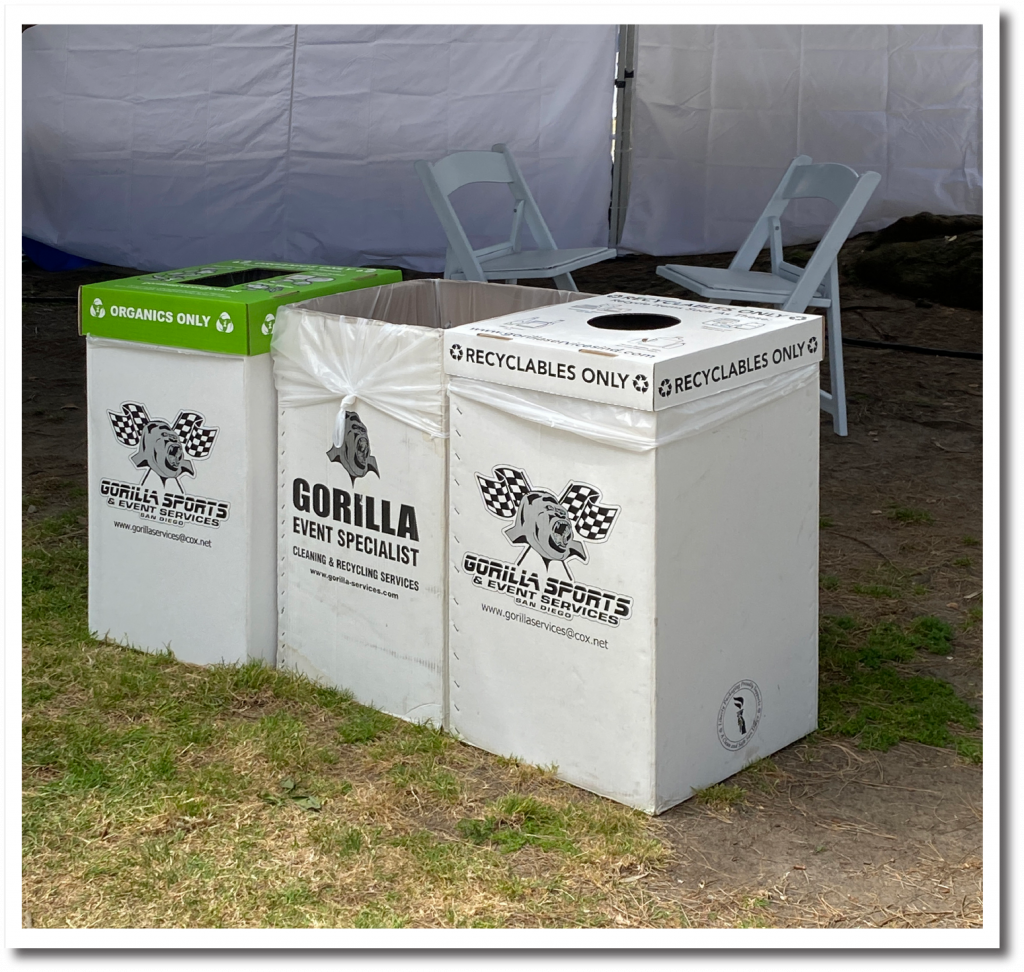
Sorry, I couldn’t help it.








